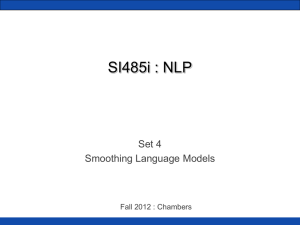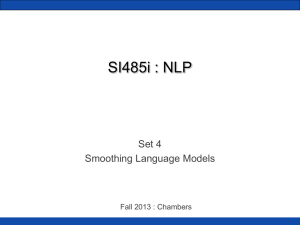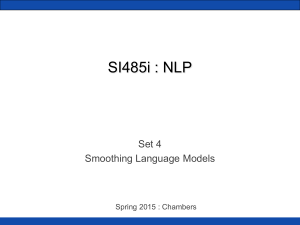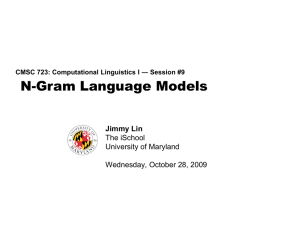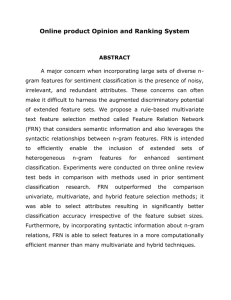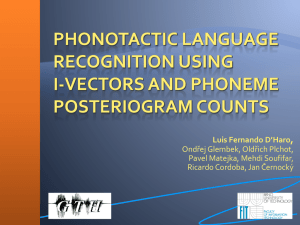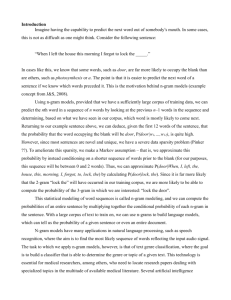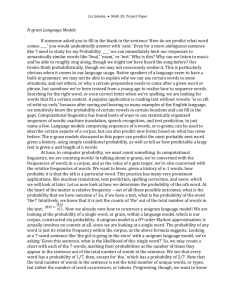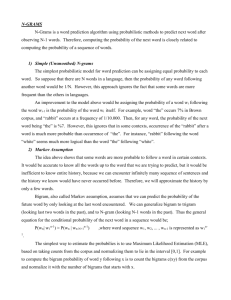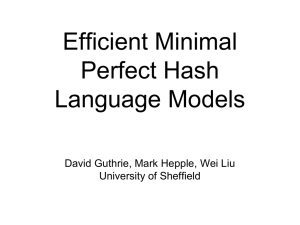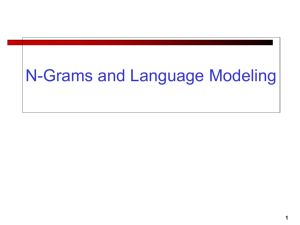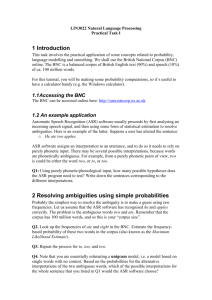Document 10835608
advertisement
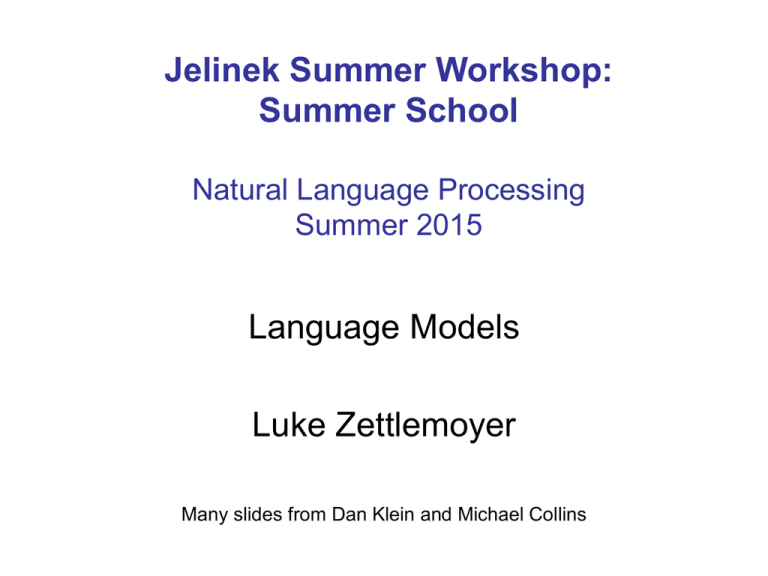
Jelinek Summer Workshop:
Summer School
Natural Language Processing
Summer 2015
Language Models
Luke Zettlemoyer
Many slides from Dan Klein and Michael Collins
Overview
§ The language modeling problem
§ N-gram language models
§ Evaluation: perplexity or end task
§ Smoothing
§ Add-N
§ Linear Interpolation
§ Discounting Methods
§ Collins lecture notes:
§ http://www.cs.columbia.edu/~mcollins/lm-spring2013.pdf
The Language Modeling Problem
n
Setup: Assume a (finite) vocabulary of words
n
We can construct an (infinite) set of strings
V † = {the, a, the a, the fan, the man, the man with the telescope, ...}
n
Data: given a training set of example sentences x
n
Problem: estimate a probability distribution
X
x
p(the) = 10
p(x) = 1
13
0 for all x ⇥ V †
12
p(the fan saw Beckham) = 2 ⇥ 10
p(the fan saw saw) = 10
...
n
12
p(the fan) = 10
V†
and p(x)
p(a) = 10
V†
Question: why would we ever want to do this?
15
8
The Noisy-Channel Model
n
We want to predict a sentence given acoustics:
n
The noisy channel approach:
Acoustic model: Distributions
over acoustic waves given a
sentence
Language model:
Distributions over sequences
of words (sentences)
Acoustically Scored Hypotheses
the station signs are in deep in english
the stations signs are in deep in english
the station signs are in deep into english
-14732
-14735
-14739
the station 's signs are in deep in english
-14740
the station signs are in deep in the english
the station signs are indeed in english
-14741
-14757
the station 's signs are indeed in english
the station signs are indians in english
-14760
-14790
the station signs are indian in english
-14799
the stations signs are indians in english
the stations signs are indians and english
-14807
-14815
ASR System Components
Language Model
source
P(w)
best
w
Acoustic Model
w
decoder
channel
P(a|w)
observed
a
argmax P(w|a) = argmax P(a|w)P(w)
w
w
a
Translation: Codebreaking?
§ “Also knowing nothing official about, but having
guessed and inferred considerable about, the
powerful new mechanized methods in cryptography
—methods which I believe succeed even when one
does not know what language has been coded—one
naturally wonders if the problem of translation could
conceivably be treated as a problem in
cryptography. When I look at an article in Russian, I
say: ‘This is really written in English, but it has been
coded in some strange symbols. I will now proceed
to decode.’ ”
§ Warren Weaver (1955:18, quoting a letter he wrote in 1947)
MT System Components
Language Model
source
P(e)
best
e
Translation Model
e
decoder
channel
P(f|e)
observed
f
argmax P(e|f) = argmax P(f|e)P(e)
e
e
f
Learning Language Models
§ Goal: Assign useful probabilities P(x) to sentences x
§ Input: many observations of training sentences x
§ Output: system capable of computing P(x)
§ Probabilities should broadly indicate plausibility of sentences
§ P(I saw a van) >> P(eyes awe of an)
§ Not grammaticality: P(artichokes intimidate zippers) ≈ 0
§ In principle, “plausible” depends on the domain, context, speaker…
§ One option: empirical distribution over training sentences…
c(x1 . . . xn )
p(x1 . . . xn ) =
for sentence x = x1 . . . xn
N
§ Problem: does not generalize (at all)
§ Need to assign non-zero probability to previously unseen sentences!
Unigram Models
§ Simplest case: unigrams
p(x1 . . . xn ) =
n
Y
p(xi )
i=1
§ Generative process: pick a word, pick a word, … until you pick STOP
§ As a graphical model:
x1
x2
………….
xn-1
STOP
§ Examples:
§
§
§
§
§
[fifth, an, of, futures, the, an, incorporated, a, a, the, inflation, most, dollars, quarter, in, is, mass.]
[thrift, did, eighty, said, hard, 'm, july, bullish]
[that, or, limited, the]
[]
[after, any, on, consistently, hospital, lake, of, of, other, and, factors, raised, analyst, too, allowed,
mexico, never, consider, fall, bungled, davison, that, obtain, price, lines, the, to, sass, the, the, further,
board, a, details, machinists, the, companies, which, rivals, an, because, longer, oakes, percent, a,
they, three, edward, it, currier, an, within, in, three, wrote, is, you, s., longer, institute, dentistry, pay,
however, said, possible, to, rooms, hiding, eggs, approximate, financial, canada, the, so, workers,
advancers, half, between, nasdaq]
§ Big problem with unigrams: P(the the the the) >> P(I like ice cream)!
Bigram Models
§ Condition on previous single word:
p(x1 . . . xn ) =
n
Y
i=1
p(xi |xi
1)
§ Generative process: pick START, pick a word conditioned on previous one,
repeat until to pick STOP
§ Graphical Model:
START
x1
x2
xn-1
STOP
§ Any better?
§ [texaco, rose, one, in, this, issue, is, pursuing, growth, in, a, boiler, house, said, mr.,
gurria, mexico, 's, motion, control, proposal, without, permission, from, five, hundred,
fifty, five, yen]
§ [outside, new, car, parking, lot, of, the, agreement, reached]
§ [although, common, shares, rose, forty, six, point, four, hundred, dollars, from, thirty,
seconds, at, the, greatest, play, disingenuous, to, be, reset, annually, the, buy, out, of,
american, brands, vying, for, mr., womack, currently, sharedata, incorporated, believe,
chemical, prices, undoubtedly, will, be, as, much, is, scheduled, to, conscientious,
teaching]
§ [this, would, be, a, record, november]
§ But, what is the cost?
N-Gram Model Decomposition
§ k-gram models (k>1): condition on k-1 previous words
n
Y
p(x1 .LANGUAGE
. . xn ) =
q(x
i |xi (k 1) . . . xi 1 )
1.3. TRIGRAM
MODELS
i=1
LANGUAGE
MODELS
where
xi 2 V [ {ST OP } and x
we would have
§ Example: tri-gram
k+2
. . . x0 7= ⇤
p(the dog barks STOP) = q(the|*, *)⇥q(dog|*, the)⇥q(barks|the, dog
TOP) = q(the|*, *)⇥q(dog|*, the)⇥q(barks|the, dog)⇥q(STOP|dog, barks)
Note that in this expression we have one term for each word in the se
dog,
barks,
and
STOP).
Each
word
only
the
. xi 1 ) two
xpression
we have
one
term for
each
worddepends
in theq(x
sentence
i |xi on
(k (the,
1) . .previous
§ Learning:
estimate
the
distributions
the trigram
assumption.
TOP).isEach
word depends
only on the previous two words: this
mption. The parameters satisfy the constraints that for any trigram u, v, w,
s satisfy the constraints that for any trigram u, v, w,
More N-Gram Examples
Higher Order N-grams?
Please close the door
Please close the first window on the left
198015222 the first
194623024 the same
168504105 the following
158562063 the world
…
14112454 the door
----------------23135851162 the *
197302 close the window
191125 close the door
152500 close the gap
116451 close the thread
87298 close the deal
----------------3785230 close the *
3380 please close the door
1601 please close the window
1164 please close the new
1159 please close the gate
…
0 please close the first
----------------13951 please close the *
Unigram LMs are Well Defined Dist’ns*
§ Simplest case: unigrams
p(x1 . . . xn ) =
n
Y
p(xi )
i=1
§ Generative process: pick a word, pick a word, … until you pick STOP
§ For all strings x (of any length): p(x)≥0
§ Claim: the sum over string of all lengths is 1 : Σxp(x) = 1
§ Step 1: decompose sum over length (p(n) is prob. of sent. with n words)
X
p(x)
x
§ Step 2: For each length, inner sum is 1
§ Step 3: For stopping prob. ps=P(STOP), we get a geometric series
§ Question: What about the n-gram case?
N-Gram Model Parameters
§ The parameters of an n-gram model:
§ Maximum likelihood estimate: relative frequency
qM L (w) =
c(w)
c(v, w)
c(u, v, w)
, qM L (w|v) =
, qM L (w|u, v) =
, ...
c()
c(v)
c(u, v)
where c is the empirical counts on a training set
§ General approach
Training Counts
§ Take a training set X and a test set X’
§ Compute an estimate of the qs from X
§ Use it to assign probabilities to other sentences, such as those in X’
198015222 the first
194623024 the same
168504105 the following
158562063 the world
…
14112454 the door
----------------23135851162 the *
14112454
q(door|the) =
2313581162
= 0.0006
Regular Languages?
§ N-gram models are (weighted) regular languages
§ Many linguistic arguments that language isn’t regular.
§ Long-distance effects: “The computer which I had just put into the
machine room on the fifth floor ___.”
§ Recursive structure
§ Why CAN we often get away with n-gram models?
§ PCFG LM (later):
§ [This, quarter, ‘s, surprisingly, independent, attack, paid, off, the,
risk, involving, IRS, leaders, and, transportation, prices, .]
§ [It, could, be, announced, sometime, .]
§ [Mr., Toseland, believes, the, average, defense, economy, is,
drafted, from, slightly, more, than, 12, stocks, .]
Measuring Model Quality
§ The goal isn’t to pound out fake sentences!
§ Obviously, generated sentences get “better” as we increase the
model order
§ More precisely: using ML estimators, higher order is always
better likelihood on train, but not test
§ What we really want to know is:
§
§
§
§
Will our model prefer good sentences to bad ones?
Bad ≠ ungrammatical!
Bad ≈ unlikely
Bad = sentences that our acoustic model really likes but aren’t
the correct answer
Measuring Model Quality
§ The Shannon Game:
§ How well can we predict the next word?
grease 0.5
sauce 0.4
dust 0.05
When I eat pizza, I wipe off the ____
….
Many children are allergic to ____
mice 0.0001
I saw a ____
….
§ Unigrams are terrible at this game. (Why?)
the
1e-100
§ How good are we doing?
Compute per word log likelihood (M words, m test sentences si):
m
1 X
l=
log p(si )
M i=1
Measuring Model Quality
§ But, we usually report perplexity
m
X
1
2 l where l =
log p(si )
M i=1
§ Lower is better!
1
§ Example: |V| = N and q(w| . . .) =
N
§ uniform model à perplexity is N
§ Interpretation: effective vocabulary size (accounting for statistical
regularities)
§ Typical values for newspaper text:
§ Uniform: 20,000; Unigram: 1000s, Bigram: 700-1000, Trigram: 100-200
§ Important note:
§ It’s easy to get bogus perplexities by having bogus probabilities
that sum to more than one over their event spaces. Be careful in
labs!
Measuring Model Quality (Speech)
§ Word Error Rate (WER)
insertions + deletions + substitutions
true sentence size
Correct answer:
Andy saw a part of the movie
Recognizer output:
And he saw apart of the movie
§ The “right” measure:
§ Task error driven
§ For speech recognition
§ For a specific recognizer!
WER: 4/7
= 57%
§ Common issue: intrinsic measures like perplexity are
easier to use, but extrinsic ones are more credible
Sparsity
§ Problems with n-gram models:
§ Synaptitute
§ 132,701.03
§ multidisciplinarization
§ New n-grams: even more often
§ Zipf’s Law
Fraction Seen
§ New words appear all the time:
1
0.8
0.6
Unigrams
0.4
Bigrams
0.2
Rules
0
0
200000
§ Types (words) vs. tokens (word occurrences)
§ Broadly: most word types are rare ones
§ Specifically:
400000
600000
800000
Number of Words
§ Rank word types by token frequency
§ Frequency inversely proportional to rank
§ Not special to language: randomly generated character strings
have this property (try it!)
§ This is particularly problematic when…
§ Training set is small (does this happen for language modeling?)
§ Transferring domains: e.g., newswire, scientific literature, Twitter
1000000
Parameter Estimation
§ Maximum likelihood estimates won’t get us
very far
qM L (w) =
c(w)
c(v, w)
c(u, v, w)
, qM L (w|v) =
, qM L (w|u, v) =
, ...
c()
c(v)
c(u, v)
§ Need to smooth these estimates
§ General method (procedurally)
§ Take your empirical counts
§ Modify them in various ways to improve
estimates
§ General method (mathematically)
§ Often can give estimators a formal statistical
interpretation … but not always
§ Approaches that are mathematically obvious
aren’t always what works
3516 wipe off the excess
1034 wipe off the dust
547 wipe off the sweat
518 wipe off the mouthpiece
…
120 wipe off the grease
0 wipe off the sauce
0 wipe off the mice
----------------28048 wipe off the *
Smoothing
benefits
motion
charges
request
claims
reports
P(w | denied the)
3 allegations
2 reports
1 claims
1 request
7 total
allegations
§ We often want to make estimates from sparse statistics:
…
benefits
motion
charges
request
claims
reports
P(w | denied the)
2.5 allegations
1.5 reports
0.5 claims
0.5 request
2 other
7 total
allegations
allegations
§ Smoothing flattens spiky distributions so they generalize better
…
§ Very important all over NLP (and ML more generally), but easy to do badly!
§ Question: what is the best way to do it?
Smoothing: Add-One, Etc.
§ Classic solution: add counts (Laplace smoothing)
qadd
(w) = P
c(w) +
c(w) +
=
0
c() + |V|
w0 (c(w ) + )
§ Add-one smoothing especially often talked about
§ Bayesian: Can be derived from Dirichlet / multinomial conjugacy prior shape shows up as pseudo-counts
§ Problem: works quite poorly!
Linear Interpolation
§ Problem: qM L (w|u, v) is supported by few counts
§ Classic solution: mixtures of related, denser histories:
q(w|u, v) =
3 qM L (w|u, v)
+
2 qM L (w|v)
+
1 qM L (w)
§ Is this a well defined distribution?
§ Yes, if all λi≥0 and they sum to 1
§ The mixture approach tends to work better than add-δ
approach for several reasons
§ Can flexibly include multiple back-off contexts
§ Good ways of learning the mixture weights with EM (later)
§ Not entirely clear why it works so much better
§ All the details you could ever want: [Chen and Goodman, 98]
Experimental Design
§ Important tool for optimizing how models generalize:
Validation
Data
Training Data
Test
Data
§ Set a small number of hyperparameters that control the degree of
smoothing by maximizing the (log-)likelihood of validation data
§ Can use any optimization technique (line search or EM usually easiest)
§ Examples:
quni
c(v, w) + qM L (w)
P
(w|v) =
0) + q
0 ))
w
(w
(c(v,
0
M
L
w
q(w|u, v) =
3 qM L (w|u, v)
+
2 qM L (w|v)
+
L
k
1 qM L (w)
Held-Out Reweighting
§ What’s wrong with add-d smoothing?
§ Let’s look at some real bigram counts [Church and Gale 91]:
Count in 22M Words
Actual c* (Next 22M)
Add-one’s c*
Add-0.0000027’s c*
1
0.448
2/7e-10
~1
2
1.25
3/7e-10
~2
3
2.24
4/7e-10
~3
4
3.23
5/7e-10
~4
5
4.21
6/7e-10
~5
Mass on New
9.2%
~100%
9.2%
Ratio of 2/1
2.8
1.5
~2
§ Big things to notice:
§ Add-one vastly overestimates the fraction of new bigrams
§ Add-0.0000027 vastly underestimates the ratio 2*/1*
§ One solution: use held-out data to predict the map of c to c*
Absolute Discounting
§ Idea 1: observed n-grams occur more in training than they will later:
Count in 22M Words
Future c* (Next 22M)
1
0.448
2
1.25
3
2.24
4
3.23
§ Absolute Discounting (Bigram case)
§ No need to actually have held-out data; just subtract 0.75 (or some d)
⇤
c (v, w) = c(v, w)
c⇤ (v, w)
0.75 and q(w|v) =
c(v)
§ But, then we have “extra” probability mass
↵(v) = 1
X c⇤ (v, w)
w
c(v)
§ Question: How to distribute α between the unseen words?
Katz Backoff
§ Absolute discounting, with backoff to unigram estimates
⇤
c (v, w) = c(v, w)
↵(v) = 1
X c⇤ (v, w)
w
§ Define the words into seen and unseen
c(v)
A(v) = {w : c(v, w) > 0} B(v) = {w : c(v, w) = 0}
§ Now, backoff to maximum likelihood unigram estimates for unseen
words
( ⇤
qBO (w|v) =
c (v,w)
c(v)
↵(v) ⇥
P
qM L (w)
0
w0 2B(v) qM L (w )
If w 2 A(v)
If w 2 B(v)
§ Can consider hierarchical formulations: trigram is recursively backed
off to Katz bigram estimate, etc
§ Can also have multiple count thresholds (instead of just 0 and >0)
Good-Turing Discounting*
§ Question: why the same discount for all n-grams?
§ Good-Turing Discounting invented during WWII by Alan
Turing and later published by Good. Frequency
estimates were needed for Enigma code-breaking effort.
§ Let nr be the number of n-grams x for which c(x) = r
§ Now, use the modified counts
nr+1
c (x) = (r + 1)
i↵ c(x) = r, r > 0
nr
⇤
§ Then, our estimate of the missing mass is:
n1
↵(v) =
N
§ Where N is the number of tokens in the training set
Kneser-Ney Backoff*
§ Idea: Type-based fertility
§ Shannon game: There was an unexpected ____?
§ delay?
§ Francisco?
§ “Francisco” is more common than “delay”
§ … but “Francisco” (almost) always follows “San”
§ … so it’s less “fertile”
§ Solution: type-continuation probabilities
§ In the back-off model, we don’t want the unigram estimate pML
§ Instead, want the probability that w is allowed in a novel context
§ For each word, count the number of bigram types it completes
§ KN smoothing repeatedly proven effective
§ [Teh, 2006] shows it is a kind of approximate inference in a hierarchical
Pitman-Yor process (and other, better approximations are possible)
What Actually Works?
§ Trigrams and beyond:
§ Unigrams, bigrams
generally useless
§ Trigrams much better (when
there’s enough data)
§ 4-, 5-grams really useful in
MT, but not so much for
speech
§ Discounting
§ Absolute discounting, GoodTuring, held-out estimation,
Witten-Bell, etc…
§ See [Chen+Goodman]
reading for tons of graphs…
[Graphs from
Joshua Goodman]
Data vs. Method?
§ Having more data is better…
10
9.5
100,000 Katz
9
100,000 KN
Entropy
8.5
1,000,000 Katz
8
1,000,000 KN
7.5
10,000,000 Katz
7
10,000,000 KN
6.5
all Katz
6
all KN
5.5
1
2
3
4
5
6
7
8
9 10 20
n-gram order
§ … but so is using a better estimator
§ Another issue: N > 3 has huge costs in speech recognizers
Tons of Data?
§ Tons of data closes gap, for extrinsic MT evaluation
Beyond N-Gram LMs
§ Lots of ideas we won’t have time to discuss:
§ Caching models: recent words more likely to appear again
§ Trigger models: recent words trigger other words
§ Topic models
§ A few recent ideas
§ Syntactic models: use tree models to capture long-distance
syntactic effects [Chelba and Jelinek, 98]
§ Discriminative models: set n-gram weights to improve final task
accuracy rather than fit training set density [Roark, 05, for ASR;
Liang et. al., 06, for MT]
§ Structural zeros: some n-grams are syntactically forbidden, keep
estimates at zero [Mohri and Roark, 06]
§ Bayesian document and IR models [Daume 06]
